Fig. 2. Early and sustained regression of a widely metastatic peritoneal mesothelioma.
(A to C) Representative axial CT images of chest and abdomen for patient 5 before treatment (A), after receiving two cycles of therapy (1.6 months) (B), and at 8 months of follow-up (C). Representative tumor involvement is indicated by red asterisks. (D) The magnitude of tumor response in this patient is shown by graphing the sum of target lesions at time points when CT scans were obtained. The horizontal dashed line represents partial response, defined as a 30% reduction in the sum of target lesions from pretreatment CT scan. The asterisk at 12 months of follow-up indicates tumor progression. (E to G) [18F]FDG PET images from time points corresponding to (A) to (C), respectively. (H) Change in tumor metabolic activity as measured by SULpeak/cm3 before therapy and at different time points after treatment. The horizontal dashed line represents metabolic partial response, as described in (25).

